Forum Replies Created
-
AuthorPosts
-
 Nick JamesParticipant
Nick JamesParticipantThe CRS-11 launch has been scrubbed due to bad weather at the Cape. Next opportunity is Saturday.
 Nick JamesParticipant
Nick JamesParticipantAll three talks are now available to members via the meeting page here.
 Nick JamesParticipant
Nick JamesParticipantAfter yesterday’s meeting at Burlington House Peter Carson has obtained some more astrometry of this object. I’ve added that to the collection and the output from findorb is attached. As I said at the meeting yesterday the period and perihelion date are very poorly constrained at the moment and the residuals aren’t much different if you force the orbit to be parabolic. Astrometry over the next couple of weeks should start to resolve that so we should at least have a good idea of the orbit. It will be a few years before we can even guess how bright it is likely to be when it comes to perihelion in 2023.
 Nick JamesParticipant
Nick JamesParticipantYes, many congratulations to Ron. Here’s an image of the new SN taken a couple of minutes ago.
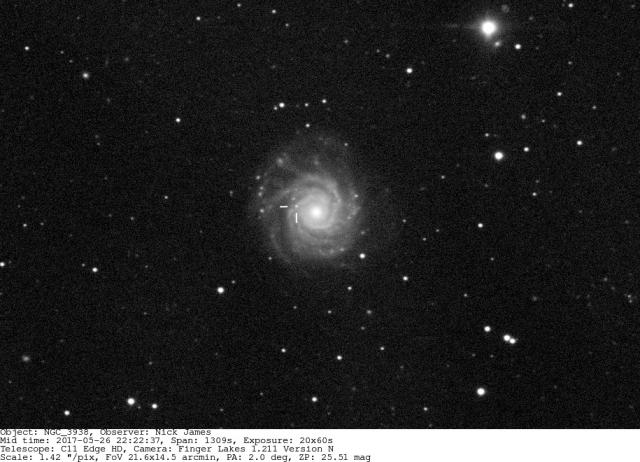
 Nick JamesParticipant
Nick JamesParticipantGreat pic.
 Nick JamesParticipant
Nick JamesParticipantIndeed. Excellent achievement. It would be good to see the thesis online.
 Nick JamesParticipant
Nick JamesParticipantMichael. We use a sony voice recorder and a video recorder that goes in the HDMI/VGA path between the laptop and projector. I can’t remember the model number of this but it wasn’t too expensive. Jeremy or Dominic will know the details if you need them. We then merge the audio and video together to produce the final recording.
 Nick JamesParticipant
Nick JamesParticipantIt was a fantastic weekend with brilliant weather, excellent talks and great company.
Those at Winchester will know that I had set myself the challenge of imaging all four of the relatively bright comets around at the moment even though the pesky Moon was almost full. 41P and 2015V2 are the subject of our current Observing Challenge and they were relatively easy since they were near the zenith, 2017 E4 was a bit more difficult since it was only around 15 deg up at dawn and 2015 ER61 was the hardest of the bunch since it was only 5 deg up when the sky was getting very bright. I used a Megrez 72 refractor at f/4.8 with a Canon EOS600D on a Vixen Sphynx mount set up on the lower football field. I’m pleased to say that after an alarm clock malfunction on the Saturday I managed to get them all on the Sunday. The attached montage shows them all at the same scale. A full-res version of this picture is available via the link.

 Nick JamesParticipant
Nick JamesParticipantThis comet is running much brighter than expected and it is now reasonably placed for the UK as a morning object low in the east at the start of astronomical twilight. John Toone found it by accident this morning while observing AG Peg and described it as looking a bit like a globular cluster in large binoculars.
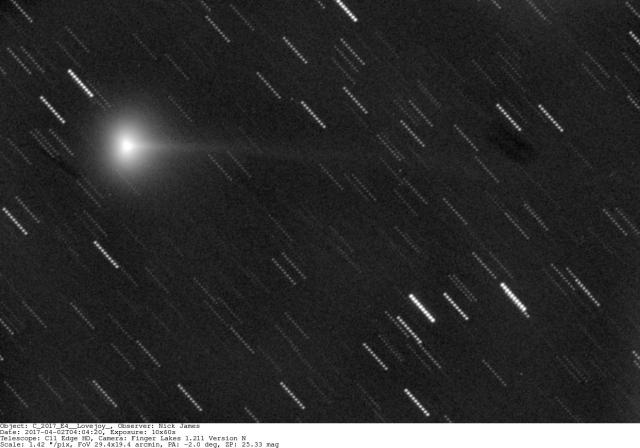
 Nick JamesParticipant
Nick JamesParticipantMany thanks for the positive feedback.
 Nick JamesParticipant
Nick JamesParticipantGlad you saw it visually Peter. This IC is relatively easy at 8 deg elongation. I have seen Venus at previous conjunctions when the elongation was only 5 deg. You need to be really careful and have a very clear sky. In fact, I also remember trying to see a comet very close to the Sun using one of Denis’ telescopes. We were very careful and one advantage of a dome is that we could block out the Sun so that there was no chance of getting it in the telescope. There is a picture of me doing that somewhere but it is probably best not published for health and safety reasons.
 Nick JamesParticipant
Nick JamesParticipantYes, it was almost certainly in outburst when discovered back in 1952. Unlike today, there were very few people doing astrometry then so the orbit is based on only 7 position measurements over an arc of 26 days. That, and the fact that the orbit will have been changed by relatively close encounters with Jupiter mean that it is very unlikely to be recovered with a specific search. The fact that it has not been picked up by the big professional surveys means that it must be intrinsicly very faint. I’m not sure where Guide 9 gets its data from but it could do with being revised.
 Nick JamesParticipant
Nick JamesParticipantThe attached ephemeris is from JPL Horizons however, as Martin says, the orbit is very uncertain and it isn’t likely to be near these locations.
 Nick JamesParticipant
Nick JamesParticipantTerry Lovejoy’s latest comet, C/2017 E4, is now just visible from UK latitudes (52N). At the end of a long clear night of comet observing I imaged it at 0415 UT when the comet was 11 deg above the horizon and the Sun was 14 deg down. It’s not a very good image compared with observers further south and it only shows the brightest central part of the coma but it is there! Visual observers are putting it around 9th mag but the observing circumstances remain challenging for the UK.
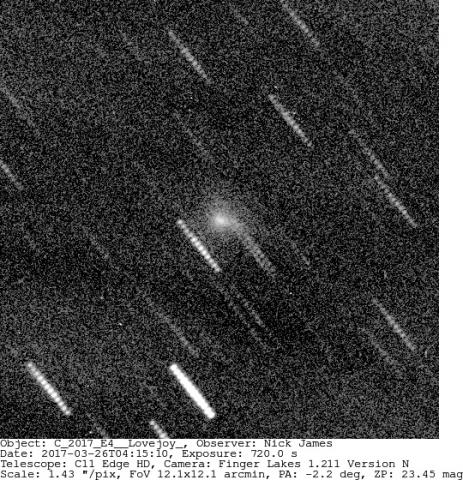
 Nick JamesParticipant
Nick JamesParticipantChris,
Your image has gone AWOL. I had cirrus problems too but it has just cleared although the seeing is dreadful. Here’s a single frame from my video taken about 30 mins ago.
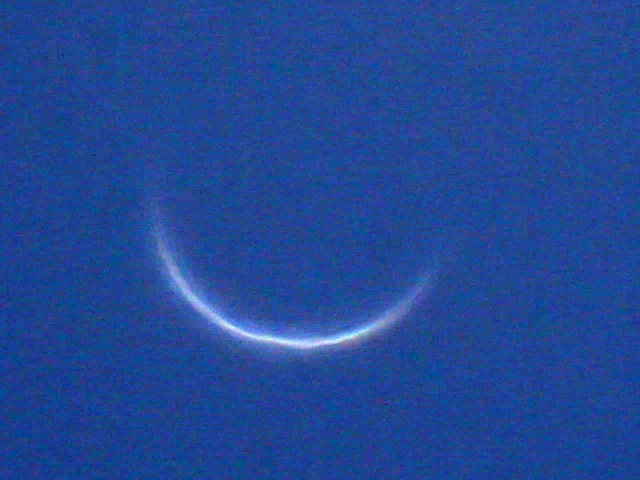
 Nick JamesParticipant
Nick JamesParticipantVery nice image! I’ve just been looking at it visually here but it is very difficult since there is a lot of cirrus around, most of which seems to have come from aircraft contrails.
 Nick JamesParticipant
Nick JamesParticipantNice images. Being the Comet Section director you’d think I would know what I was doing when it comes to observing comets but I’m not so sure. I’d made a reservation on one of the iTelescope scopes to get the M108 conjunction and was surprised at lunchtime that I hadn’t received any notification that an image was waiting. On investigation this was becuase I’d made the reservation for tomorrow! Damned timezones…
 Nick JamesParticipant
Nick JamesParticipantVenus is now a very thin crescent only 11 degrees from the Sun. It reaches its closest angular distance on Saturday when it will be 8 degrees away. This is a video from this afternoon in windy conditions. Don’t try this unless you really know what you are doing. Pointing a telescope anywhere near the Sun can be very dangerous. The picture is a single still from the video. At some point I need to put this through Registax.
The video was shot with a Canon 550D in 640×480 centre crop video mode using a Celestron 6 with a x2 Barlow.
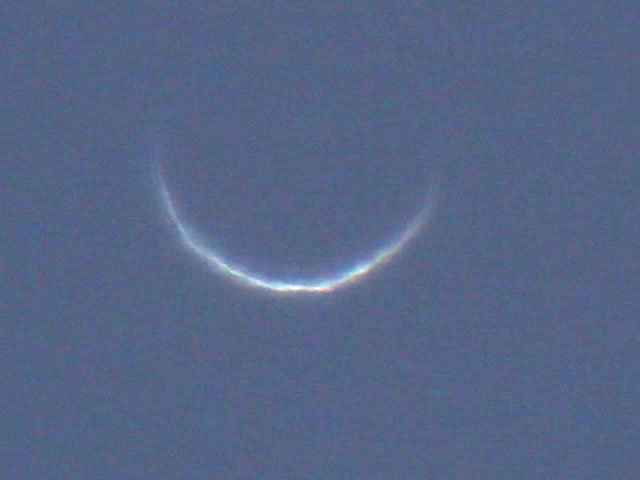
 Nick JamesParticipant
Nick JamesParticipantNice image. It really is great fun following Venus at this point in its orbit. From our latitude Venus is almost directly above the Sun at sunset now so the horns of the crescent are pointing upwards. Your image is also a great demonstration of atmospheric dispersion with blue light being refracted upwards more than red. I’m hoping we’ll get some more clear opportunities over the next few days.
 Nick JamesParticipant
Nick JamesParticipantMPEC 2017-E86 confirms this object as C/2017 E4 (Lovejoy).
-
AuthorPosts
